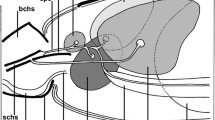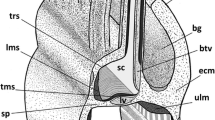Summary
The architecture of the basal region of the subcommissural organ (SCO) and the subjacent neuropil was studied in the brush-tailed possum, Trichosurus vulpecula (Marsupialia). Several structural features suggest that the basal mode of SCO-secretion may be as prominent as the well-established apical secretion. Some of the features that speak in favour of basal secretion are: (1) the existence of deep processes of secretion-laden SCO cells which reach and surround the capillaries in the hypendyma and the subjacent neuropil; (2) the presence of perivascular spaces, some of which may contain a material that resembles the secretory product of the SCO; (3) positive staining by means of paraldehyde-fuchsin of secretory material in the pericapillary zone of vessels in the hypendyma and its corresponding neuropil; (4) presence of labyrinths of the basal lamina of capillaries and associated nerves. The presence of nerve and other cell processes adjacent to the perivascular space, labyrinths and capillary wall suggests discharge into the capillaries of material such as the basal secretory product of the SCO. However, the absence of fenestrae in capillary endothelium in the context of the foregoing observations is enigmatic and speaks against the possibility of a conventional release of secretion. Nevertheless, it is possible that a secretory product containing particles of low molecular weight combined with some specific features of the local capillary endothelium, which facilitate transport, may be critical factors making possible transfer of such product(s) from the SCO to the capillaries.
Similar content being viewed by others
References
Afifi AK (1964) The subcommissural organ of the camel. J Comp Neurol 123:139–146
Barer R, Lederis K (1967) Ultrastructure of the rabbit neurohypophysis with special reference to the release of hormones. Z Zellforsch 75:201–239
Barlow RM, D'Agostino AN, Cancilla PA (1967) A morphological and histochemical study of the subcommissural organ of the young and old sheep. Z Zellforsch 77:299–315
Casley-Smith JR (1982) The structure and functioning of the blood interstitial tissues and lymphatics. In: Földi M, Casley-Smith JR (eds) Lymphangiology. Schattauer Verlag, Stuttgart New York, pp 45–60
Drury RAB, Wallington EA (1967) In: Carlton's histological technique. Oxford University Press, New York
Duvernoy H, Koritké JG (1964) Contribution à l'étude de l'angioarchitectonie des organes circumventriculaires. Arch Biol 75 (Suppl):849–904
Ferraz de Carvalho CA, Reis FP (1977) Histological and ultrastructural study on the subcommissural organ of Bradypus tridactylus. Anat Anz 141:373–390
Fleischhauer K (1972) Ependyma and subependymal layer. In: Bourne G (ed) The structure and function of nervous tissue. Academic Press, New York London, pp 9–13
Gabe M (1953) Sur quelques applications de la coloration par la fuchsine-paraldéhyde. Bull Micros Appl Deuxieme Serie 3:153–162
Gabriel KH (1970) Vergleichend-histologische Studien am Subcommissuralorgan. Anat Anz 127:129–170
Herrlinger H (1970) Licht- und elektronenmikroskopische Untersuchungen am Subcommissuralorgan der Maus. Erg Anat Entwickl 42:7–73
Isomaki AM, Kivalo E, Talanti S (1965) Electron microscopic structure in the calf (Bos taurus) with special reference to secretory phenomenon. Ann Acad Sci Fenn III:1–64
Kimble JE, Mollgard K (1973) Evidence for basal secretion in the subcommissural organ of the adult rabbit. Z Zellforsch 142:223–239
Lederis K (1965) An electron microscopical study of the human neurohypophysis. Z Zellforsch 65:847–868
Leonhardt H (1972) Electron microscopical differences between subependymal labyrinths of the basal membrane in the human, in the rat, and in the rabbit. Verb Anat Ges 67:605–607
Leonhardt H (1980) Ependym und Circumventriculäre Organe. In: Oksche A, Vollrath L (eds) Handbuch der mikroskopischen Anatomie des Menschen, Band 4; Nervensystem, Teil 10, Neuroglia I. Springer, Berlin Heidelberg New York, pp 177–666
Murakami M, Nakaya Y, Tanaka H (1969) Fine structure of the perivascular space of the Gecko japonicus subcommissural organ. Experientia 25:522–523
Murakami M, Nakayama Y, Shimada T, Amagase B (1970) The fine structure of the subcommissural organ of the human foetus. Arch Histol Jpn 31:529–540
Murakami M, Shimada T, Oribe T, Hiraki T (1972) An electron microscopic study of the subcommissural organ of the monkey, Macacus fuscatus. Arch Histol Jpn 34:61–72
Naumann RA, Wolf DE (1963) Striated intercellular material in rat brain. Nature 198:701–703
Oksche A (1969) The subcommissural organ. J Neuro-Visc Relations Suppl 9:111–139
Olsson R (1958) Studies on the subcommissural organ. Acta Zool 39:71–102
Palkovits M (1965) Morphology and function of the subcommissural organ. Studia Biol Acad Scient Hung 4:1–105
Rodríguez EM (1970) Ependymal specializations III. Ultrastructural aspects of the basal secretion of the toad subcommissural organ. Z Zellforsch III:32–50
Sterba G, Kiebig C, Naumann W, Petter H (1982) The secretion of the subcommissural organ: A comparative immunocytochemical investigation. Cell Tissue Res 226:427–439
Talanti S (1966) The subcommissural organ of the reindeer (Rangifer tarandus) with reference to secretory phenomena. Anat Anz 119:99–103
Tulsi RS, Kennaway DJ (1979) Observations on the secretions of the subcommissural organ and the pineal in the adult brush-tailed possum (Trichosurus vulpecula). Neuroendocrinology 28:264–272
Wakahara M (1974) An ultrastructural study of the subcommissural organ cells of the African clawed toad, Xenopus laevis. Cell Tissue Res 152:239–252
Weindl A (1973) Neuroendocrine aspects of circumventricular organs. In: Ganong WF, Martini L (eds) Frontier in neuroendocrinology. Oxford University Press, New York, pp 3–32
Wetzstein R, Schink A, Stanka P (1963) Die periodisch strukturierten Körper im Subcommissuralorgan der Ratte. Z Zellforsch 61:493–523
Author information
Authors and Affiliations
Rights and permissions
About this article
Cite this article
Tulsi, R.S. Architecture of the basal region of the subcommissural organ in the brush-tailed possum (Trichosurus vulpecula). Cell Tissue Res. 232, 637–649 (1983). https://doi.org/10.1007/BF00216435
Accepted:
Issue Date:
DOI: https://doi.org/10.1007/BF00216435




